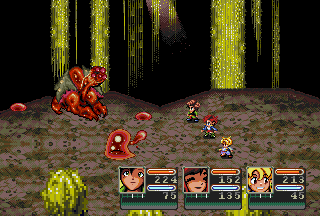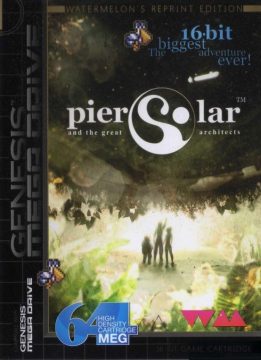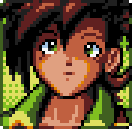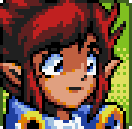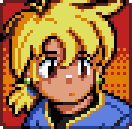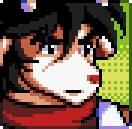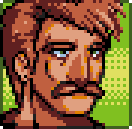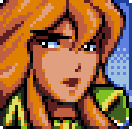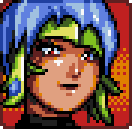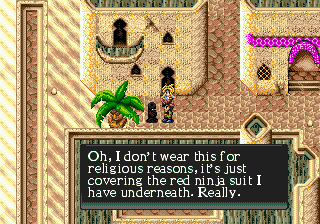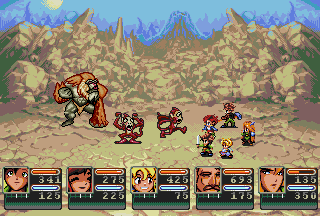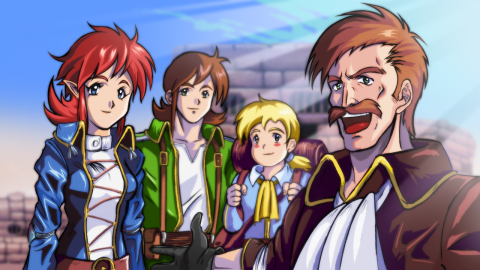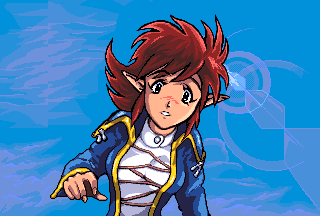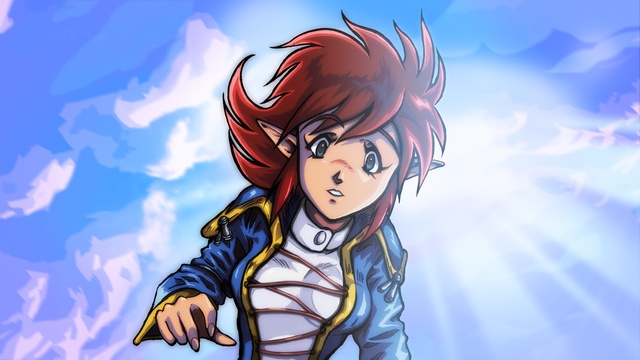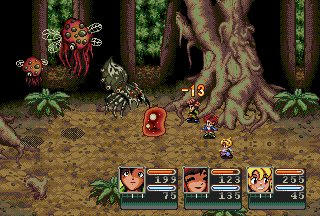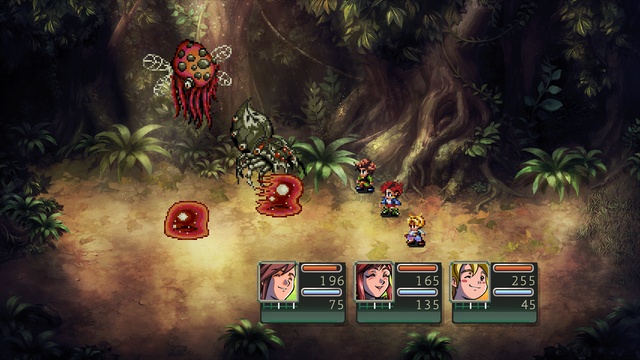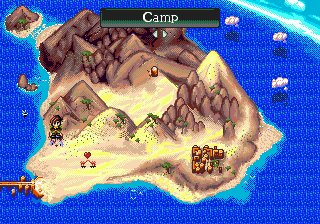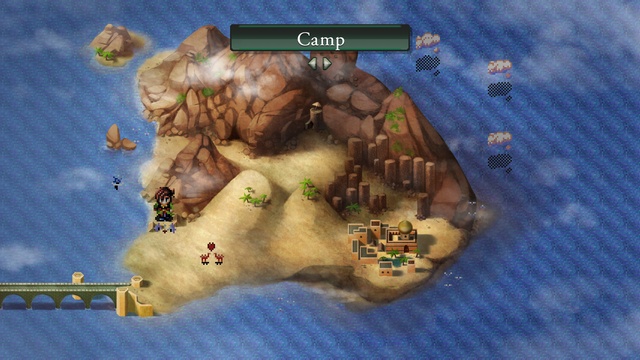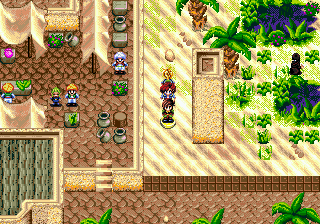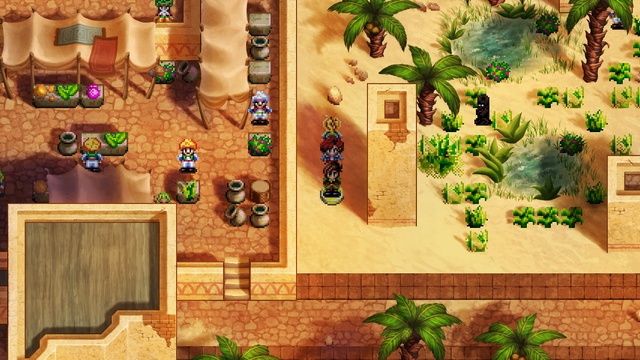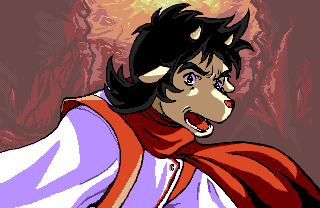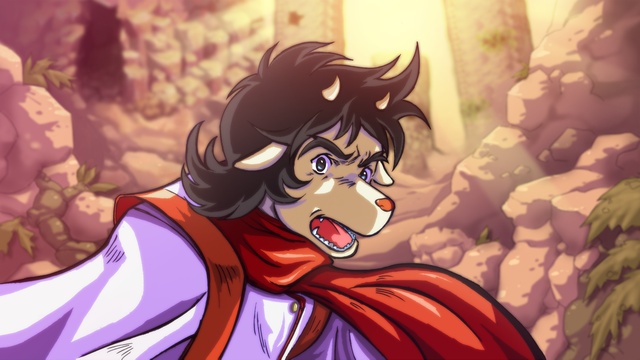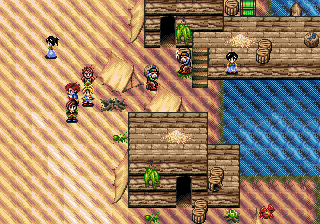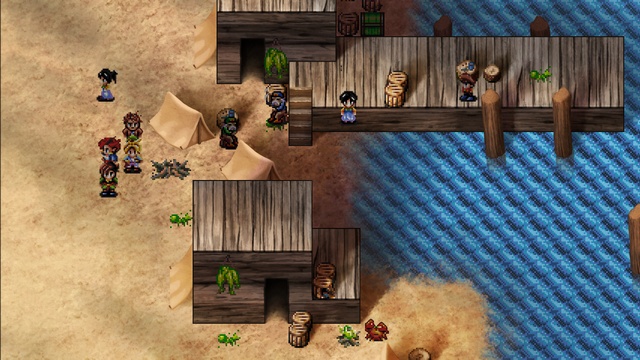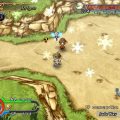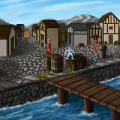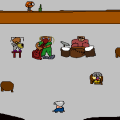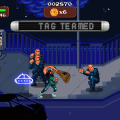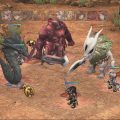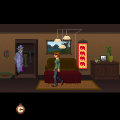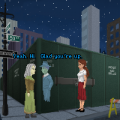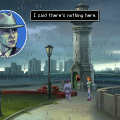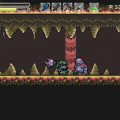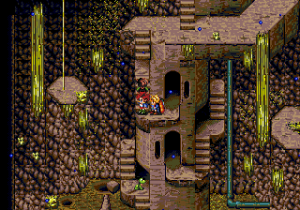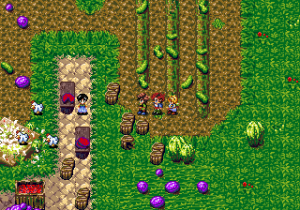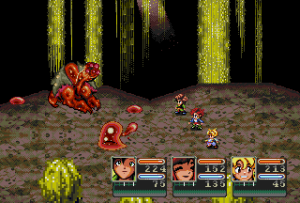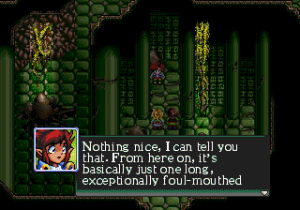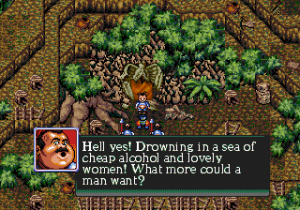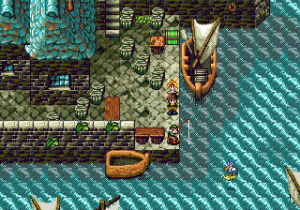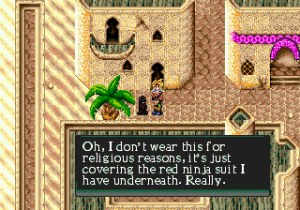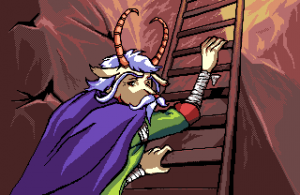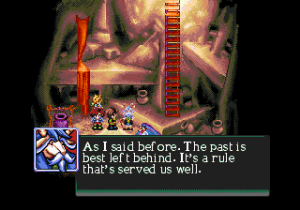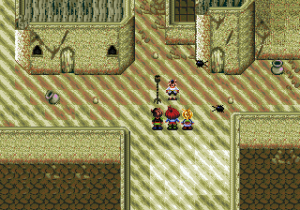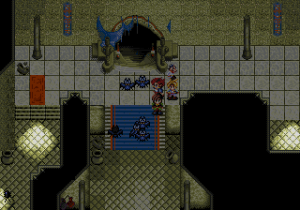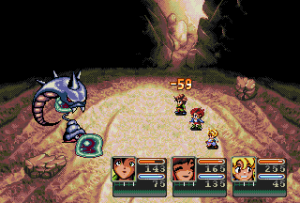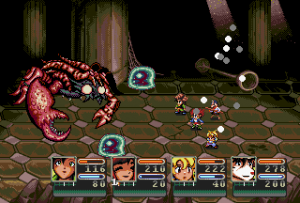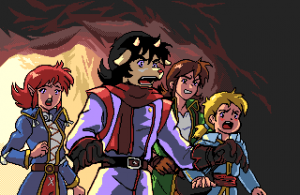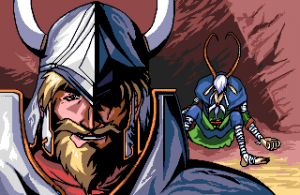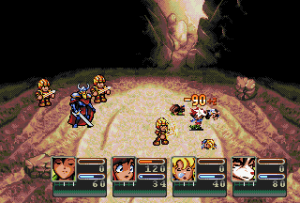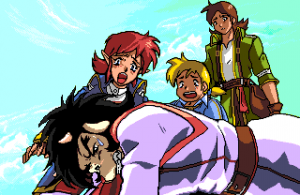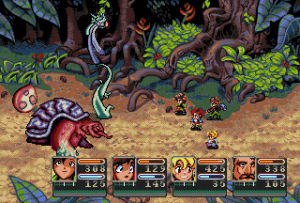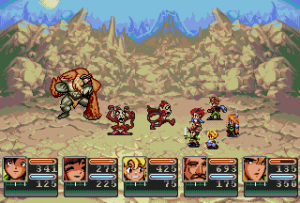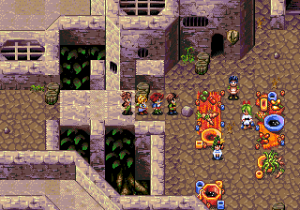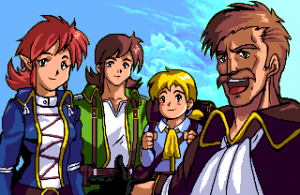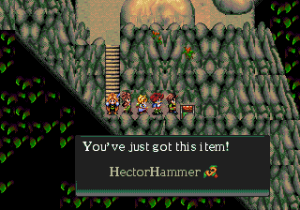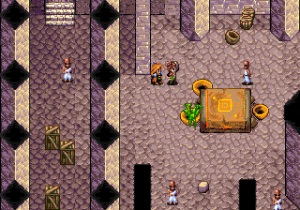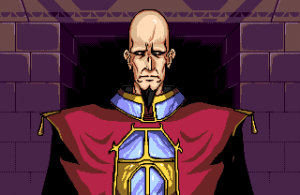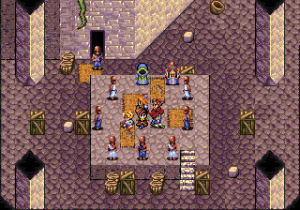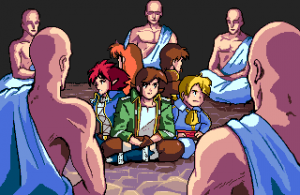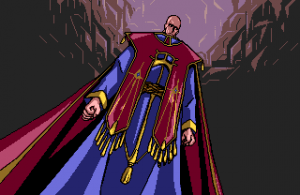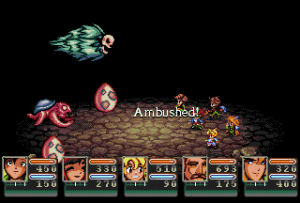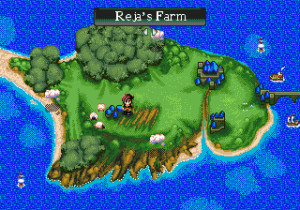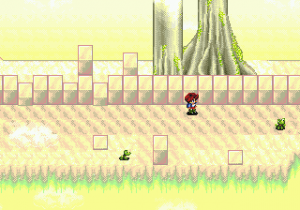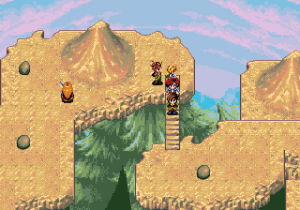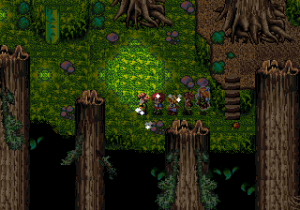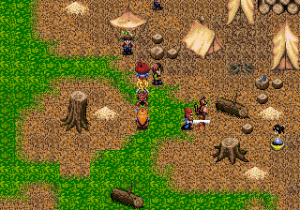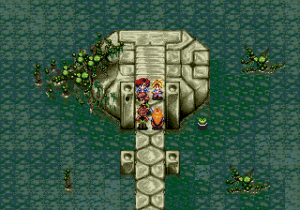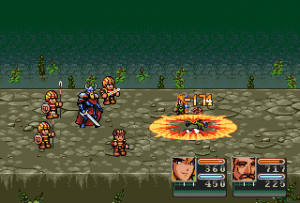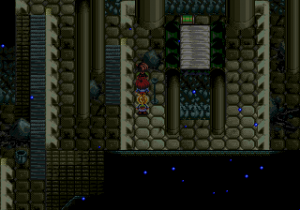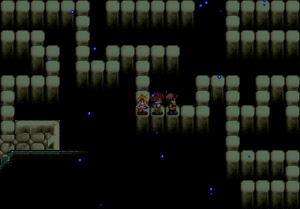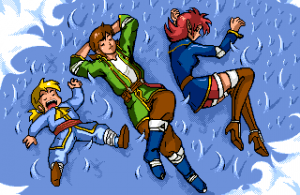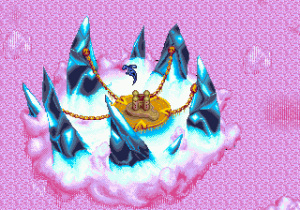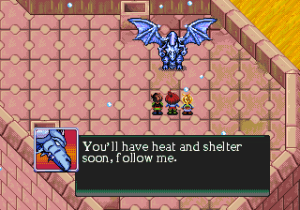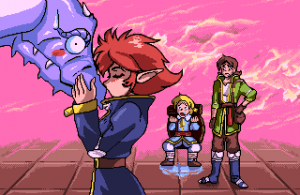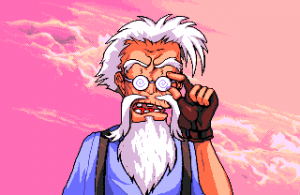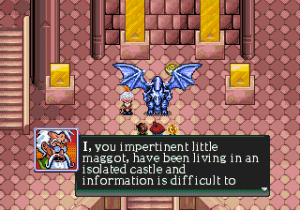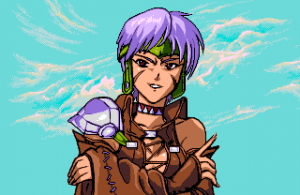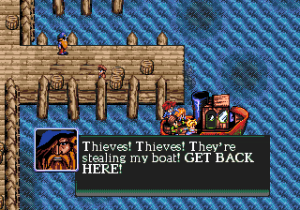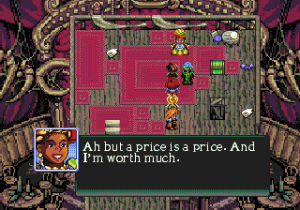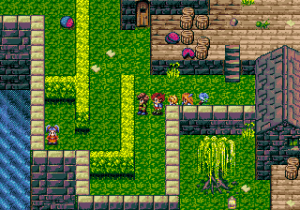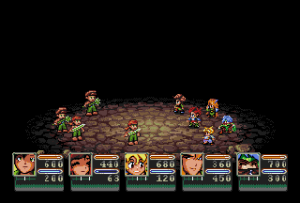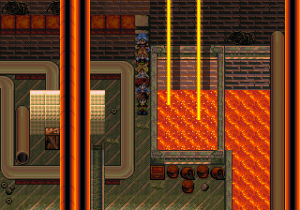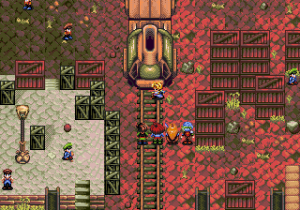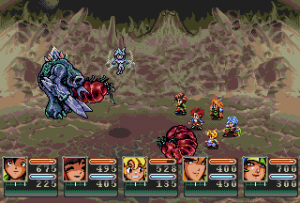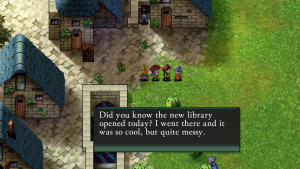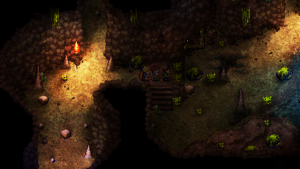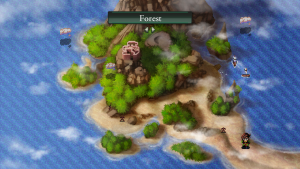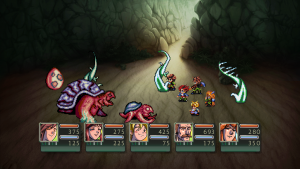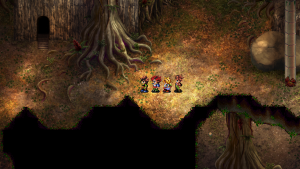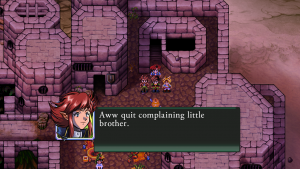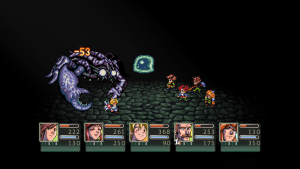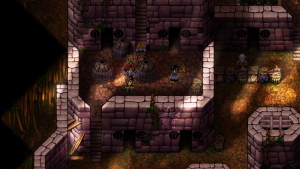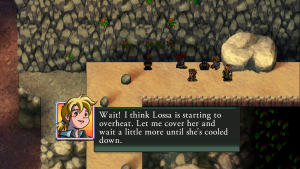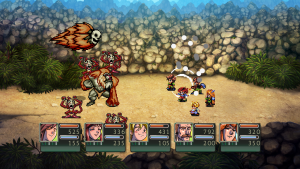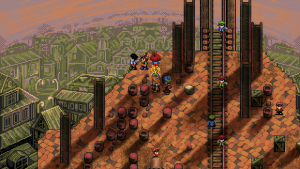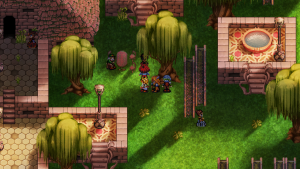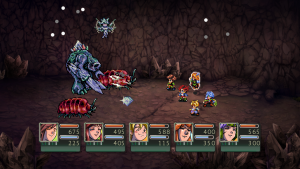It’s strange how some consoles become the domain of one particular genre after their commercial lifespan. Sega’s Dreamcast, for example, has seen more 2D shoot-em-ups after its discontinuation than before, and if you’re buying a Genesis game that was published in this millennium, chances are it’s an RPG. What distinguishes Pier Solar from offerings like Beggar Prince and Legend of Wukong is the fact that it’s not an old obscure game from Taiwan merely localized for new audiences, but an entirely original creation made by indie developers.
Pier Solar was not only made for an old 16-bit console, it was also made to give the impression of a game that would have been made in the 16-bit days. Thus the premise feels heavily conventional – three children in a generic fantasy world explore a forbidden cave near their village, where they happen upon the remains of an ancient civilization a warning. Following the trail, they find themselves dragged into events that far exceed their former mundane world view. It’s very explicitly inspired by Game Arts/Studio Alex’ Lunar series.
Characters
Hoston
He is the son of a florist and knows a lot about herbs. Otherwise he’s a stereotypical JRPG protagonist – young, plucky, helpful, good-hearted, bland. He kicks off the adventure when he ventures into the forbidden cave to find herbs to cure his terminally ill father.
Alina
A brave and well-educated girl… with daddy issues. She desperately attempts to win the recognition of her adopted father, the stiff archaeologist Murto. Alina can be relied to school the boys about history and ancient languages when needed. She tends to call both Hoston and Edessot “little brother” for no good reason, and the two are sure to protest about it each time.
Edessot
A thirteen-year-old master inventor (yes, it’s one of those RPGs…) who moved out from his parents’ home and lives alone in his workshop. Not all his inventions work as intended, though, especially his newest creation, the navigation robot Lossa. He and Hoston keep on bickering with each other at every opportunity.
Mohu
He and his mentor are the last members of an ancient race that was driven to near extinction by humans. He only joins the group for a brief time, and upon his parting he tasks them with destroying a mysterious artifact – a compass handed down to him by his former tribe.
Rudy
Hoston’s father is a florist now, but in his youth he used to assist Murto during his excavations. After he recovers from his illness, he joins the children and reveals that he used to work with a secret society that seeks to control all knowledge of the forgotten age.
Kruller
An old acquaintance of Rudy who stumbles onto the scene seemingly by accident and saves the day when the kid’s are threatened by the cruel knight Ironhart. Despite being trained in arcane magic, he leads the life of a street performer and fights with juggling balls.
Zellini
A tough bounty hunter who – immediately after introducing herself openly – starts to lead the party on through a bunch of filler distractions wearing a ridiculously obvious disguise for no good reason. Then at one point she decides out of nowhere to reveal herself again and to join the team permanently, triggering irrational jealousy in Alina.
Fortunately, the writing in Pier Solar is not as verbose as in many other indie RPGs. The story is still up to a very slow start, and for the longest time the three kids just stumble along because they’re curious little brats. This may be enough motivation for them, but for players it’s demanding a lot of patience to go on for four or five hours before they’re even presented with a proper quest. When the mysteries and conspiracies finally start to get introduced, the terse writing style is both a blessing and a curse: The game never bores with too much exposition, but often it’s not quite clear what is going on or why the next suggested step should be of any use. The lack of direction goes so far that often it’s not even clear what to do next because the instructions are too vague. A lot of back and forth is then required to find the invisible trigger for the next key event. And about halfway through the adventure, the game suddenly decides that you have to select quest items from the inventory at specific locations manually instead of just having them while interacting with the right target. The brevity is still preferable to the more common alternative, but there ought to be some middle ground somewhere in between.
Even though the writing in general is above par for indie games, the language is a bit shaky as well. The script is fine for long stretches, but every once in a while there are sentences that seem so unnatural and badly translated it can really take you out of the experience. (This is talking about the English text, which is supposed to be the original, but maybe the writers weren’t native speakers? Or maybe they were just spoiled by too many bad Japanese-to-English translations) The game’s attempts at humor deserve a special scolding, because they fall flat every single time – and there are so many of these bad one-liners when talking to random NPCs. The tone is all over the place, too. Some jokes seem like a five-year-old might find them funny, others are baffingly ribald and family-unfriendly. Especially the silly video game references can really take you out of the story – the party can find several Genesis cartridges for no reason, and at one point the script can’t stop itself elaborating that, yes, hedgehogs are really fast. But the worst are the completely unnecessary and inappropriate jabs at religion and the religious that crop up in NPC dialogue several times. There is a time and a place for militant atheist propaganda, but a fantasy land where magic is real and middle schoolers can save the world by killing actual evil gods is hardly it. Another soapbox the writers like to jump onto comes in the form of some hamfisted environmentalist messages.
Many towns are unusually large for a console style 2D RPG, with lots of houses the party cannot enter and other structures that are merely there for decoration. This helps making them more believable places, but it also means that you have to spend a lot of time finding your way around. Dungeons are even larger and quite mazelike. From the very beginning, they trick players with invisible passages, elevator puzzles and one-way slides. The many optional hidden treasures would make them fun places to explore, but there are a lot of items that, once missed, can never be retrieved again. There is one spell early on in particular that’s easily missed, which causes a chain reaction of blocked content further down the line. The focus on exploration in the dungeons just doesn’t mix well with the very linear structure of the quest, with several points of no return.
Then there is the bane of traditional console RPGs – random encounters. The combat system sounds fun at first, but after prolonged play several crippling issues become evident. While progression is strictly turn-based, all the stronger spells have to be charged up via the “gather” command. Doing so uses up a turn, but gathered points can be passed along to other party members. The charges are not used up by casting spells, either, and last for the duration of the entire fight. This may create interesting dynamics during boss fights, but ordinary encounters just feel dragging because of it. Regular enemies can take quite a while to beat in general, and many feel more like mini bosses, with some devastating attacks and leaders who keep summoning more minions until they’re defeated.
This is all good and well, but the problem is they’re not mini bosses. The party can walk around quite a while before getting dragged into another random fight, but due to the large labyrinthine dungeons that demand a lot of backtracking, the same enemy formation is still encountered dozens of times. Each area only has two different battles, the player has no influence on character stat growth whatsoever, and aside from a few accessory items, there’s not much in terms of temporary buffs or other means to change the dynamics. After a few repetitions, any encounter just becomes mind-numbingly tedious. The excruciatingly long animations for many of the spells and even some regular attacks certainly don’t help, either. Eventually Edessot has the opportunity to find and learn an optional spell that greatly reduces the encounter rate, but until then you’d be best advised to keep something else to do at hand to fall back to while waiting for the excruciatingly slow combat rounds.
Enemies come in two general types, ground and air based. Only certain attacks can hit a flying enemy, but it’s possible to use blocking to bait them into a counter attack. This immediate retaliation makes blocking more useful than in most other RPGs, but unless you just have to save the wounded mage until he can perform the uber spell he’s been charging up, it’s still a waste of a turn more often than not, because there is no means to estimate or manipulate which party members are going to be attacked. Counter attacking only becomes truly viable when you find accessories that automatize it – which renders the defense command obsolete again. WaterMelon clearly had some great ideas to make JRPG style combat more interesting, but they’re all squandered in execution.
The balancing is rather player friendly, and it’s rarely necessary to grind for levels in order to keep up with enemy strength. You can even run away from a battle every once in a while without the party becoming underpowered. However, ambushes occur a bit too frequently and can bring a severe penalty depending on the enemy type. Resting locations are typically few and far between, and often a lot of backtracking is required to heal up. Once the party gets back on the overview map, locations to travel to can be easily selected, but sometimes access to the nearest inn is blocked by the story, which can have rather awful implications. The save system is also odd – the “save” command can be selected from the menu at any time, but the state that is being saved is not actually the current situation, but the state when the current location was entered, which is quite counter-intuitive. There are also some later areas are so big that you have to go on without any opportunity to properly save for too long.
There are also a handful of mini games, ranging from simple “capture the rabbits” contests to simple Bomberman clones, which can be accessed from the menu once they’ve been unlocked in the main game, and allow up to four players to compete against each others. They’re a welcome change of pace, but not very substantial to the experience.
If anything, Pier Solar is the best-looking RPG on the Genesis. WaterMelon likes to brag that it’s the largest cartridge game for the system, and it shows. Important characters have little portrait pictures for their dialog lines and there are full screen illustrations to depict a number of key scenes, which used to be the domain of CD based games only back in the day. The environments are made of skilled pixel art that does a great job of concealing the Genesis’ limited color palette. Most enemies have several animations for idling, attacking, moving around the battlefield or getting hit. In addition to the human inhabitants and monsters, the world is populated with critters like frogs, bats, rabbits or bugs that make places seem more alive. The only thing lacking is the variety of the graphics. Brownish tones are awfully prominent throughout, there is only a small number of different enemies, and even some of the few bosses are repeated with different color palettes.
Pier Solar comes with a full FM soundtrack, but Sega CD owners can also plug in the companion CD (which was packaged with the first release but relegated to a downloadable ISO for later reprints) to have all the music replaced with PCM remixes. The CD soundtrack has more instruments, sounds a lot softer and more natural, although the FM musician knew how to handle the Genesis chip as well. It does have the typical slightly metallic sound, but it is never offensive to the ears, as it was in so many of the lesser Genesis soundtracks. The compositions are also excellent, with few exceptions. The CD also contains ROM images for some early alpha builds of the game and a couple of illustrations, which can be accessed when the CD is inserted in a PC CD-ROM drive. There are also some nice subtle environmental sound effects, but the standard combat sounds are the typical Genesis scratches and bleeps.
The initial release of Pier Solar wasn’t handled too well – due to several delays, WaterMelon started taking preorders years before the eventual release, and since their projected quantities turned out far below demand, the first print run was sold out months before anyone could estimate what the game would be like or even if it was real. Then immediately before release, the promised Japanese translation was cancelled and the supposed “Japanese” version shipped with English and Spanish languages only – too late for anyone to change their order to the “proper” North American (also English and Spanish) or European (English, French and German) box designs. It also had a questionable packaging choice, a cardboard box with the manual glued onto it. The Genesis version got reprinted a few times in a clamshell box, but always in limited quantities. It also seemed rather odd to limit a new game as ambitious as Pier Solar to an ancient console only the most ardent fans had held onto over the decades. So it surely was a pleasant surprise when WaterMelon launched a crowdfunding campaign to help them bring the game to almost any recent platform. But what they had in mind wasn’t just any old port, but a modern HD remaster.
However, WaterMelon’s idea of an HD remaster was quite unconventional, to say the least. The developer advertised it as “merging the rich charm of retro sprites with crisp HD backgrounds”, but it can only be called a half-finished job. Only the backgrounds and illustrations are redrawn in high resolution, but character sprites remain as the same low res pixel art. Even some other objects are left untouched. It all results in a very untidy, incoherent look. The options menu contains a setting called “HD+”, but all it does is apply a butt-ugly filter to the sprites (but not to the other SD elements). It’s a shame, too, as most of the HD graphics look decent on their own, awfully straight lines along the tile borders in the top-down view notwithstanding. Especially some of the battle screens are beautiful, but it’s all just a huge waste of effort and money because the end result is almost unbearable. The redrawn full-screen illustrations are apparently painted over the originals and look very pretty. The character portraits for the dialogue and menus, on the other hand, are all new and look somewhat cheap compared to the originals. When they appear in front of a black background, you can even see that they haven’t been properly cut out from the illustrations, and there are garbage fragments left along their hairlines. Fortunately, the original Genesis graphics are available, too. (The resolution to make the pixel art look right is 1280×720, because all the true 4:3 modes force a squished 16:9 letterbox, and in higher resolutions the pixel conversion rate doesn’t add up to a clean multiple.)
The options also allow to switch between the PCM and FM soundtracks and any time, and the emulation (or pre-recording?) for the latter is surprisingly decent. Not all options are available from within the game, though, so in order to switch between full screen HD graphics and properly boxed 16-bit graphics it’s necessary to go back to the title screen, which involves sitting through several loading times, the WaterMelon logo animation, a Mega Drive 20th Anniversary logo and a rather slow title screen buildup each time.
The save point system has been reworked, too, but while it’s better than the Genesis method, it’s still kind of messed up. In towns there is now a dedicated save point, whereas in monster-infested environments the game is saved automatically at the entrance of each area, which can get particularly annoying in the larger dungeons that are designed to wear the party down through prolonged meandering, because unless you made a copy of the save state to revert back to in an emergency, you can easily find yourself in a terrible situation in the middle of a hostile area.
A few new areas and even a new ending have been added to the remake, so ultimately it’s preferable over the original, but some options to speed up the battles and more comfortable features like instant save and quit would have been nice. There is an automap that could help a bit with maneuvering the large maps, but at least during our test, it somehow became unavailable after a while. The HD version also finally fulfills the original promise of a Japanese language version.
In either version, Pier Solar is a good enough game, but it falls short of becoming something truly special. Even back in the 16-bit era, it probably would have been considered a B-tier RPG, closer to the likes of Lufia and the Fortress of Doom or the first Breath of Fire rather than Final Fantasy VI or Phantasy Star IV, except for its really pretty presentation. On the Genesis it couldn’t hope to do the inflated aftermarket cartridge prices any justice, and even at the original pricing it would have been a tough recommendation. Not that the price was unfair or anything – it probably couldn’t have been any cheaper due to the manufacturing costs – just a reality of producing an ambitious game for an old, cartridge-based console. The digital versions, however, are a solid investment for anyone who is into JRPGs and doesn’t only look out for the best, but you need to bring quite a bit of patience for the slow battles and eye-rolling jokes.
Links:
Official Homepage
